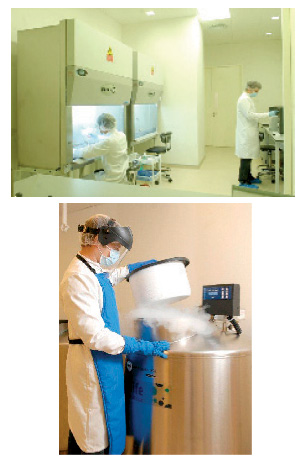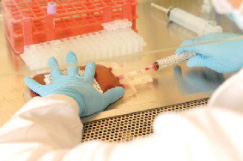Banking on stem cells
Updated: 2011-02-23 06:49
By Richard Macauley(HK Edition)
|
|||||||
|
Vincci Chan Wo Yuk-hing (left) plays games with her 5-year-old son Ivan (center) and 3-year-old daughter Gaile. Both of her children have their stem cells, taken from their umbilical cords at birth, stored in a private cord blood bank in Hong Kong. Provided to China Daily |
|
Operation in a Cordlife's laboratory in the New Territories. Provided to China Daily |
A small but growing number of parents hope to safeguard their children through programs that store umbilical cord blood to provide valuable stem cells if ever they are needed. Some experts, however, dispute the value of these costly services, calling them little more than a scam. Richard Macauley reports.
The room erupts with laughter as 3-year-old Gaile says she too likes to play football. "She doesn't," says her mother. "But what she does is repeat anything she hears from her brother."
Gaile adores her 5-year-old brother Ivan who, as he sits at the wide conference table, is busy playing with astronauts and a space shuttle.
The siblings would be the envy of any parent who have suffered with children who can't get along: they look after one another, keep each other entertained and when Ivan leaves the room Gaile is noticeably quieter without her boisterous brother by her side.
In the surprisingly cozy surroundings of the conference room the siblings are blissfully unaware that meters away in a large and pristine laboratory next door lie samples of their blood, taken from their umbilical cords at birth, now nestled silently among thousands of samples at a temperature of -190 C.
Neither of the siblings is sick; their family history offers no reason to be more concerned than any other family and they are in fact not in a hospital but a private office.
Their parents Vincci Chan Wo Yuk-hing and Mike Chan Chau-keung, however, are among the growing number of couples in Hong Kong who have taken the opportunity to capture, freeze and store the umbilical cord blood of their children.
Private cord blood banks charge parents around HK$30,000 for the storage of their child's stem cells. The idea is that they are kept so that if the child falls seriously ill he or she has immediate access to potentially life-saving stem cells. The stem cells could even be used by the immediate family, should the child's sibling or parents fall sick.
The industry has damning critics, however, who accuse private cord blood banks of preying on parents at a vulnerable time of their lives and failing to offer accurate facts about both the likelihood of needing such stem cells and even the effectiveness of the treatments offered by such companies.
Many parents are also unaware of the free alternative that may prove far more effective in the event of an illness.
To obtain cord blood stem cells, blood is extracted from the umbilical cord after the birth of a child. The stem cells are then taken from the blood sample before being cooled slowly to a temperature of -190 C, ready for use at any time client should need them.
Parents who choose to store their child's stem cells with a private bank are the sole owners of the cells and nobody else can access them for treatment. For parents, paying for storage of their child's stem cells is a form of life insurance that, should their child fall ill, could pay off.
"I'm afraid that we never know what kind of diseases our children could get in the future," says Chan. "Of course, though, there is only one chance to store cord blood and that's at the birth, so why not."
One of the major criticisms of private banking though comes from a dispute over how likely it is any person will ever need their own stem cells.
Vadanee Lau, the chief executive officer of Cryolife, a major private cord blood bank in Hong Kong, says that there is no standard measure to determine the likelihood of a person needing their own stem cells for treatment because stem cells can "treat so many diseases".

Nevertheless, she quickly adds that Cerebral palsy can be treated with stem cells taken from cord blood. "Cerebral palsy ... affects 2.5 newborn children per 1,000 in Hong Kong," she says. "That's very high."
Dr Cherie Daly, Group Medical Affairs Manager at Cordlife, another private cord blood banking company which operates in Hong Kong, says that, "the likelihood of (needing a) stem cell infusion is one in 217".
This is not the likelihood of a person's needing their own stem cells, she explains: that would be a much smaller probability. Instead, this refers to the likelihood of a person ever needing any form of stem cell infusion, in other words, an infusion of their own stem cells or an infusion from a donor.
But doctors outside the private banking industry paint a different picture. Dr Li Chi-kong, honorary clinical professor at Chinese University of Hong Kong's Department of Pediatrics, says that, "one report put the likelihood of a person needing (their own stem cells) at one in a thousand over 20 years. Personally I'd put it at around one in 100,000."
One reason doctors claim there is such a low likelihood of needing one's own stem cells is that, should a patient need any stem cell infusion at all, the odds are they will need stem cells from a donor: their own stem cells will often be insufficient for treatment.
Perhaps the clearest example of the uncertain value of privately storing stem cells is the argument over whether leukemia can be treated with a person's own cells.
Dr Anthony Chan, laboratory director at Cryolife, says that leukemia can be treated with a person's own, privately stored stem cells.
"There's a bit of a scam going on among some doctors who say that leukemia is ... probably inherited from the mother," he says. "Doctors worry that (if leukemia is hereditary) then the child's stem cells will have a predisposition to leukemia, and would advise against (using that child's own stem cells).
"Some diseases are present in cord blood," he adds. "But leukemia is not."
Dr Li disagrees, however, saying that finding such an illness in a young child would indeed suggest that the illness was present in the child's blood - and stem cells - at birth. In that case then, treating the child with their own, malignant, stem cells would at best be ineffective and at worst could risk relapse. "This is precisely why cord blood stem cell infusions (of a patient's own stem cells) are so rare when treating pediatric illnesses," he says.
The alternative option for sick patients - and expectant parents - is a public cord blood bank. These operate in the same way blood banks operate for adults, and are free to donors as well as patients in need.
Parents can donate to a public bank such as the Red Cross in Hong Kong and patients, even if sick with a hereditary disease, are then able to use stem cells for treatment at no cost.
Some doctors have gone even further in their condemnation of the industry. Dr Mitchell Cairo, director of pediatric blood and marrow transplantation at Morgan Stanley Children's Hospital of New York-Presbyterian, wrote in a 2007 report that parents are discouraged from banking with a private company as biological insurance for later personal or family use. "There is currently no scientific evidence to support the benefit of cord blood banking for the individual whose blood was donated," the report says.
In a recent interview about the industry Dr Cairo stood by the language of his report. He offered just one exception in which a private bank would prove useful; if a child was in need of a stem cell transplant and the parents conceived a second child in order to harvest the younger sibling's stem cells, this would require the storage facilities of a private bank.
"Otherwise," he says, "the overwhelming odds are that (stem cells) will never be used by the donor."
This is not to say that private companies have nothing to offer customers, however.
Dr Daly says that the purpose of private banking is as much for "improving people's quality of life", as it is saving lives. She readily admits that a person's own stem cells cannot be used to treat genetic diseases (although maintains that some kinds of leukemia can be treated with a person's own stem cells).
Dr Daly however puts the real value of private banking on the technology's "life improvement" potential, including possible treatments for rheumatoid arthritis, type 1 diabetes and multiple sclerosis. In addition to these it is believed that a person's own stem cells might soon be able to treat patients of brain injuries or nerve damage - afflictions that cannot be helped by using the stem cells of another person.
If a patient finds himself in need of a stem cell transplant but not fatally ill, Dr Daly says, it is unlikely that a public bank will give up a sample to treat them. "Donated cord blood stem cells are very precious, so using a sample for non-fatal illnesses such as cerebral palsy, type 1 diabetes or a traumatic brain injury is unlikely." If a person owns their own stem cells, however, they can use them for any purpose they please.
This focus on experimental and life improvement procedures certainly puts the private bank's claims much more in line with those of doctors in the public sector such as Dr Li and Dr Cairo.
"The most important point is that companies should notify parents that the actual chance of a person requiring an infusion (of their own stem cells) is really very low," says Dr Li. "Parents should consult the Paediatric College Medical Association to read public statements before they make a decision."
Dr Cairo similarly sees nothing wrong with the expansion of the private banking industry provided the claims made by such companies focus on what can be done with existing technology and not just what is in experimental stages. In addition, he argues that the statistical likelihood of a child needing their own stem cells should be made explicit to parents before they sign up.
He adds, however, that the best way to help most people would be to establish a larger public cord blood bank with the greatest racial mix possible for the benefit of all.
Nevertheless, a child's health is a powerful notion, and once the idea of private banking is offered to parents it is difficult to turn down.
"It's a gamble," agrees Chan as she prepares Ivan and Gaile to leave the office. "It may not even save a life but it's worth a try. If you can afford it and you choose not to do it, you could end up regretting the decision in the future."
(HK Edition 02/23/2011 page4)

